Volume 3 Issue 1 (2013) DOI:10.1349/PS1.1938-6060.A.427
"Dark Mass," or the Problems with Creative Cloud Labor
Anne Cong-Huyen
A screenshot from Crowdsourcing.org, an online community and source of information for crowdsourcing projects, briefly defines crowd creativity as the "[t]apping of creative talent pools to design and develop original art, media or content. Crowdsourcing is used to tap into online communities of thousands of creatives to develop original products and concepts, including photography, advertising, film, video production, graphic design, apparel, consumer goods, and branding concepts."1 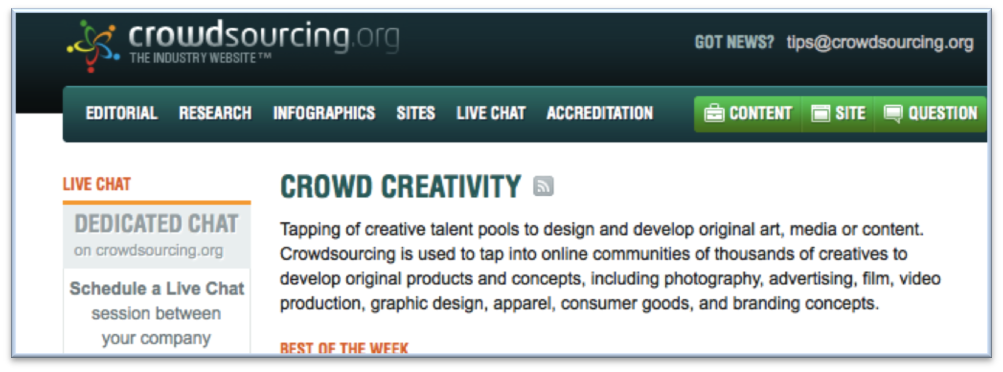
Figure 1. Screenshot of Crowd Creativity page of Crowdsourcing.org
Such an understanding of crowdsourcing creative labor, though limited, demonstrates a widespread comprehension of the results of such processes to be products of some determinable value for sale and consumption. The ideologies informing the practice of crowdsourcing arguably have roots in post-1980s capitalism as well as in the open source movement inflected by early digital utopianism. Even though these two modes seem oppositional, they both rely on the infrastructures of networked technologies that have made models of distributed labor—perhaps most infamously associated with transnational corporations in the post-1980s era of neoliberal deregulation and privatization—possible. Capitalist ventures use those networked capabilities for profit, while open source movements tend to use them to freely distribute, remix, and build texts in primarily not-for-profit endeavors. Sometimes, these two seemingly contradictory motives—profit-motivated production and community-based production and sharing—converge in crowdsourced projects that are meant to be sites of education and awareness. This emergence, as seen in the following comparative analysis of two recent crowdsourced projects, Flight Paths2 and VozMob,3 demonstrates that even within collectively produced projects, the materialization of authorship can be especially problematic in terms of representation, voice, and power.
The collectively authored "networked novel" Flight Paths and the equally collectively made blog and website VozMob (short for Voces Móviles, or Mobile Voices) represent two different modes of digital production around issues of migrant labor, in Dubai and Los Angeles respectively. I concede from the start that it is impossible and unfair to compare these two texts as equals in any way. They are both meant to create awareness for local migrant worker populations of specific global cities; but the ways in which this work is done, and the guiding vision and politics, are quite distinct for each project, making comparative work difficult, especially because both texts continue to evolve and grow. To analyze these texts, then, I employ two parallel methods of co-reading: first, looking at the ostensible narrative of the texts against the dynamics of the production process; and second, reading these texts against the more journalistic network of discourse that makes up a larger narrative encompassing those stories and their global implications. This method of correlative reading provides a way of analyzing nontraditional literary texts that were born digital—a networked novel and a blog, which are themselves embedded within larger sociopolitical contexts and structures. Within these texts and contexts, labor emerges as a subject of representation, and also as an important component of the processes that produce the texts themselves, processes that are celebrated as being collaborative in nature. Each of the texts is a product of collaborative labor facilitated through networked communication technologies, online platforms, and social networking sites, and also through community or institutional networks. This creative production, however, occurs in such a way that much of the labor is unseen and unrecognized (though perhaps for different reasons for each text) in the final legible form of the published texts. Ultimately, this article will contribute to the ongoing discussions about labor, especially creative labor, digital production, and the institutional mechanisms that reward certain types of authorship.
I will focus on Flight Paths and VozMob in relation to the locations of Dubai and Los Angeles, though I could argue that these examples are indicative of larger observable phenomena within the changing definitions of labor; this is increasingly important, considering the ways in which labor has become more temporary, contingent, outsourced, or even invisible in nearly all sectors of the economy at present. To offer a little context regarding these particular sites, Dubai and Los Angeles appear to be two disparate cities with divergent histories in terms of development and infrastructure. Los Angeles has historically been an important city for media production in the West, whereas Dubai is a city that literally rose out of the Arabian Desert in the past forty years. In that time, though, Dubai has fashioned itself into a financial and cultural capital of the Middle East and has become one of the dominant sites of media production in the region (perhaps second only to Egypt).4 Though very different in these aspects, both cities are remarkably similar in their relative importance as major nodes for transnational flow of finance capital, of goods through their ports and roads, and of people for their respective labor markets.
These positions of importance have consequently led to an influx of large populations of migrant or foreign workers.5 For Los Angeles, these workers include the Mexican agriculture and railroad workers initially recruited through the Bracero Program of the mid-20th century,6 as well as the present-day skilled workers in the United States (often of South Asian nationality) who enter on the temporary H-1B visa. Though temporary, these workers make up a very important, and very large, percentage of the skilled labor in the US technology industries. Dubai, on the other hand, could easily be called a city of foreigners, who sometimes account for up to 90 percent of its population. Nearly all of these foreigners are in Dubai to fill jobs in the private sector, namely construction, finance, leisure, or hospitality.7 Thanks to advances in both travel and communication technologies, along with developments in trade and immigration policies, these cities have become key epicenters for such movements of people and work. The move toward liberalization since the1980s has also resulted in increased deregulation, privatization, and transnationalization of corporations that is especially visible in these cities, which have seen an upsurge of in-migration of large populations from the Global South seeking employment. In some ways, these laborers, often paid significantly less than citizen workers, are necessary to the local economies, yet they have become major points of controversy. In Los Angeles, such workers make up the bulk of laborers in the agricultural, service, and manual labor industries today. Dubai, on the other hand, has a labor force that ranges anywhere from 85 to 95 percent foreign workers, with these including the more elite entrepreneurs, bankers, and technology workers, as well as the most precarious of workers: hospitality, domestic, and construction workers (the majority from South Asia or the Pacific).8
Flight Paths and VozMob focus on specific migrant worker populations in their respective cities—the construction workers of Dubai and the day laborers of Los Angeles—who are often the most invisible, exploited, and even demonized populations in each context. These workers are often blamed for everything from stealing citizens' jobs to being the cause of crime and moral turpitude, accusations often based in xenophobia and racism exacerbated by times of economic hardship. An additional, albeit more amorphous, population of interest is the individuals who contribute their intellectual labor to help produce the two texts I am examining here. Sometimes this labor can be miniscule (uploading a single image or sharing an anecdote), or it can be incredibly labor-intensive (long-term community activist blogging), but the work of these individuals often is followed by varying levels of recognition and valuation that range from international awards to total anonymity. The reasons for such variation can be the avoidance of personal harm (in the case of undocumented individuals in California), or the established practices that reward a select group of authors.
In examining these texts and contexts, it is especially valuable to look at digital texts made and distributed via the internet, because of the perception of the internet as a democratic space. As has been argued since the early 1990s by Lisa Nakamura, Anna Everett, and others, these narratives have proven to be utopian and idealistic; and as I argue in this article, even attempts to use digital tools in a collaborative and collective manner, and to incorporate a multitude of voices through the more public space of the internet, may encounter problems of power and voice, and, most problematic, may present new forms of exploitation or marginalization. Ideally, however, the use of collaborative writing platforms, including wikis and open source data management systems, for each of these projects demonstrated a potential for democratic storytelling and information dissemination, but politics and ingrained social expectations may have thwarted such goals.
First, it will help to briefly introduce the two texts. The earlier text, Flight Paths, which originally went online in December 2007, traces the story of a South Asian man, Yacub, who leaves his unnamed home to work in Dubai. This story is told in five short Flash chapters,9 or as Kate Pullinger described them in 2009, "five new story hotpoints—five little flash movies—that we hope will act as jumping off points for anyone interested in contributing"10. 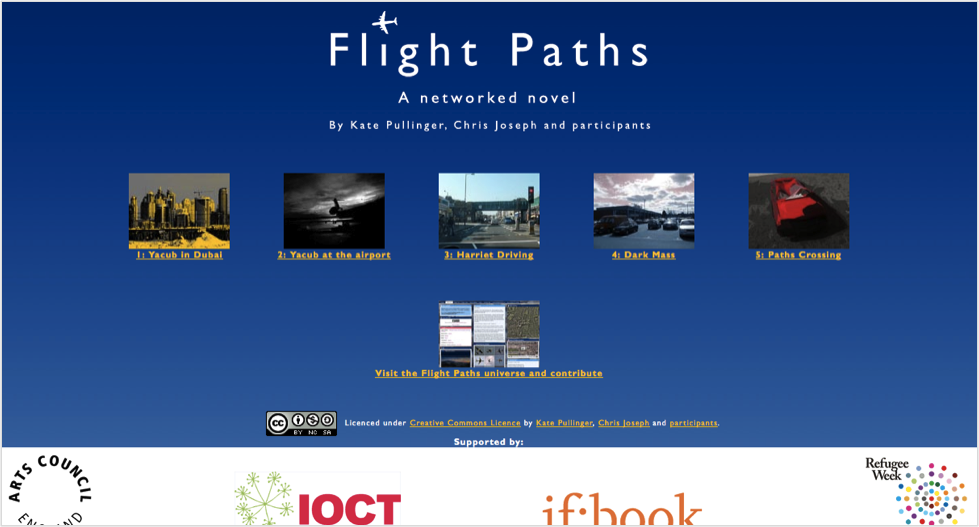
Figure 2. Screenshot of Flight Paths home page (captured April 8, 2012)
The chapters are a product of collaboration between the well-known Pullinger and multimedia writer-artist Chris Joseph, plus a larger participating public that followed the projects of the Institute for the Future of the Book (if:book), of which Flight Paths was one. A vast experiment in collaborative storytelling, Flight Paths had many large institutional sponsors, including if:book, Arts Council England, Institute of Creative Technologies (Leicester, UK), and the multi-agency-sponsored Refugee Week in the UK.
Likewise, VozMob (Figure 3) is an ongoing and award-winning project,11 involving researchers and activists from the University of Southern California Annenberg School for Communication and Journalism; the Institute of Popular Education of Southern California (IDEPSCA), a Los Angeles–area nonprofit with multiple physical locations that works with "disenfranchised people through leadership development and educational programs based on Popular Education methodology" (http://idepsca.org/); and the Los Angeles Community Action Network (LACAN).12
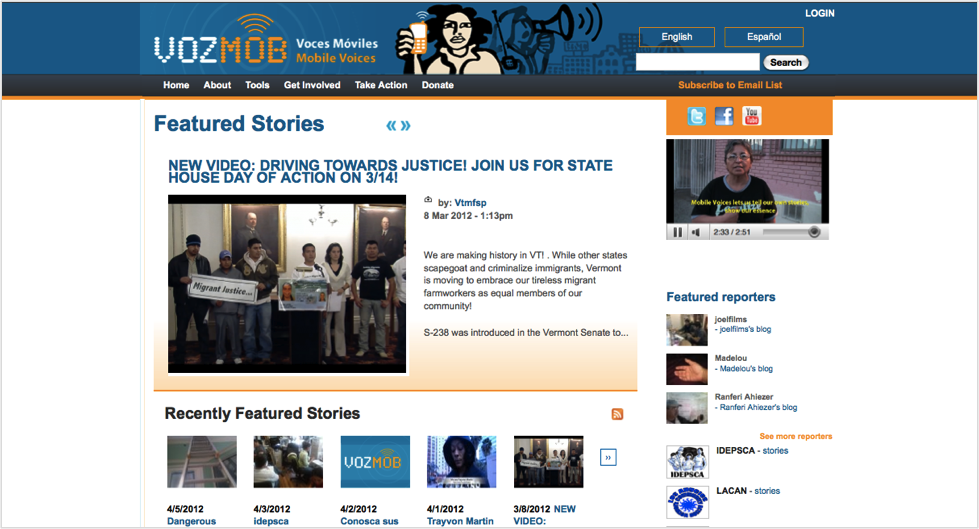
Figure 3 Screenshot of VozMob site
According to VozMob's About Vozmob page, "Mobile Voices (VozMob) is a platform for immigrant and/or low-wage workers in Los Angeles to create stories about their lives and communities directly from cell phones. VozMob appropriates technology to create power in our communities and achieve greater participation in the digital public sphere."13 Rather than tell a single narrative, as Flight Paths attempts to do, VozMob acts as an online platform through which multiple people or organizations can share information and media from a variety of individual perspectives, all of "immigrant and/or low-wage workers in Los Angeles." As opposed to Flight Paths, which seeks to incorporate a larger body of contributors around a single topic, VozMob limits the pool of contributors to a specific demographic of laborers within a certain geographic location.
Both projects ultimately have produced texts focused around specific social issues—the goals of each project—but the approaches they took in facilitating collaboration, and the way that information was and is being used, are quite different. For example, according to the Flight Paths blog, written primarily by Pullinger, "The initial goal of this project is to create a work of digital fiction, a 'networked book,' created on and through the internet."14 Thus, the goal of the project was to make a single cohesive product, a networked book, using the affordances of digital technology. This called for participants to upload material, to share stories and media inspired by a feature article in the Guardian titled "The Man Who Fell to Earth," by Esther Addley and Rory McCarthy15,
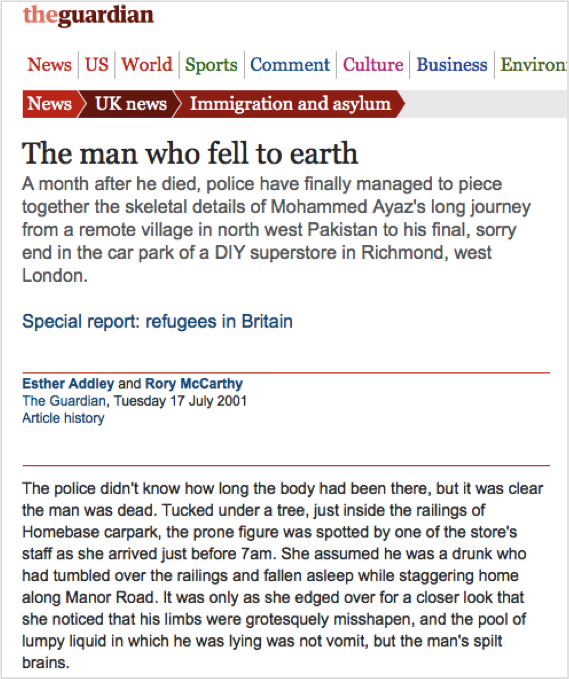
Figure 4 Screenshot of "The Man Who Fell to Earth"
which detailed how Mohamed Ayaz, who was a Pakistani man and Dubai laborer, had been found in a parking lot outside Heathrow Airport after falling out of the wheel bay of a Boeing 777 in an attempt to escape labor conditions in Dubai and to enter England. The narrative would thus be inspired by the central figure of a South Asian man who would emerge as ambiguously living, possibly even undead, and his narrative would parallel that of a British housewife, Harriet. The first figure came from the news story, and the second originated from Pullinger's imagination, as chronicled on the project's blog. In a blurb first posted on the if:book site (now found on an external blog; the initial blog that Pullinger wrote has since been reorganized following a relaunch of the site in 2009), the goals are stated in the following way:
The initial goal of this project is to create a work of digital fiction, a "networked book," created on and through the internet. The first stage of the project will include a web iteration with, at its heart, this blog, opening up the research process to the outside world, inviting discussion of the large array of issues the project touches on. As well as this, Chris Joseph and Kate Pullinger will create a series of multimedia elements that will illuminate various aspects of the story. This will allow us to invite and encourage user-generated content on this website and any associated sites; we would like to open the project up to allow other writers and artists to contribute texts—both multimedia and more traditional—as well as images, sounds, memories, ideas. At the same time, Kate Pullinger will be writing a print novel that will be a companion piece to the project overall.16
Like the news article that revived the unidentified foreign man whose life had to be pieced back together by investigative journalists and police, the Flight Paths project called on the users from the larger community to contribute a variety of media and texts that would then be used to create a larger narrative. What can be observed from the framework of this project, however, is that although the input of others is solicited, two main people work in a more active capacity to curate and shape the final project. Pullinger and Joseph also have complete control of the print novel that will be a companion to this collaboratively authored digital piece, though we can assume that it will be influenced by the digital story. Additionally, the larger online Flight Paths Universe incorporates all of the contributed media and is home to the project blog. This "universe" has seen some minor transformations since the project's inception. When I first encountered Flight Paths in 2010, the universe home page had fewer tabs, including the "About," "Blog," "New Contributions," "Previous Contributions," and "Partners/Refugee Resources" tabs.
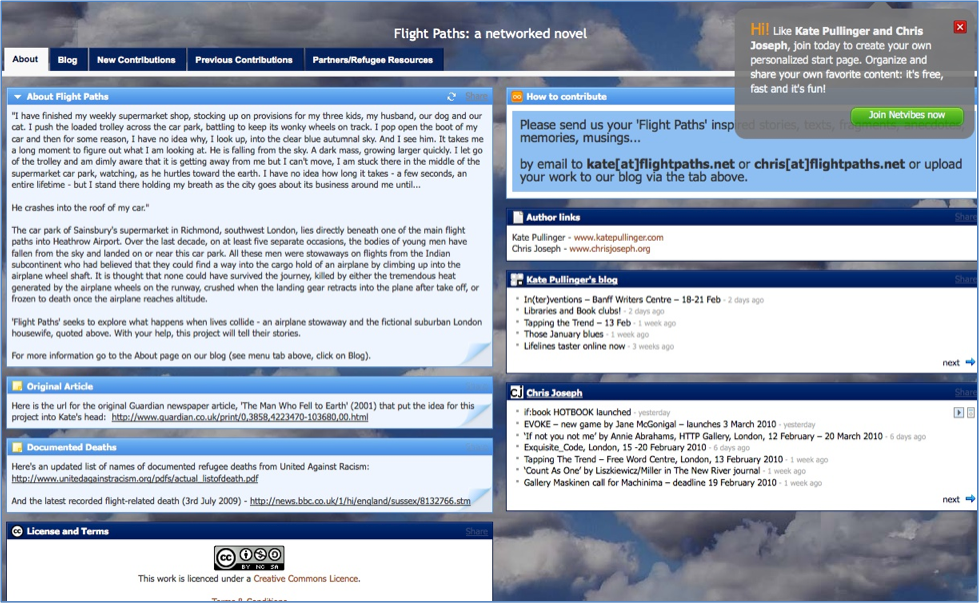
Figure 5. Screenshot of Flight Paths Universe (captured in March 2010) http://www.netvibes.com/flightpaths
Currently, the universe has an additional "Kate's Research" tab (Figure 6), signifying that the site also serves as Pullinger's online space to accumulate materials for her writing, something that other contributors cannot do (at least not as visibly or directly in relation to the Flight Paths pages).
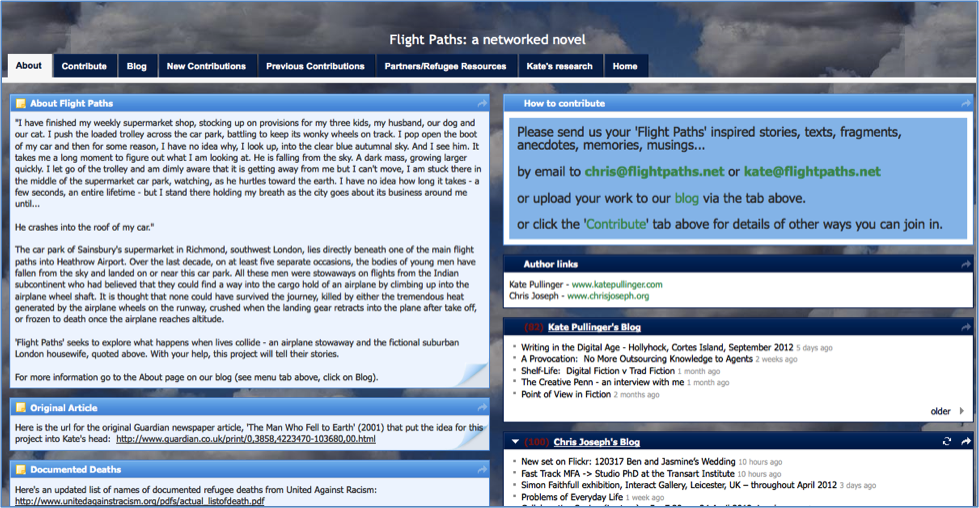
Figure 6. Screenshot of Flight Paths Universe (captured in April 2012) http://www.netvibes.com/flightpaths
In the most simplistic terms, this situating of Pullinger's work, visually on the site, privileges traditional notions of authorship that have been important to discussions of the viability of collaborative creative labor, but it also speaks to the immediate concerns of collective participation and thematic cohesiveness. Following the earlier experiment in collective novel authorship done by Penguin Books, A Million Penguins (in which Pullinger was also involved), which has been widely deemed ambitious but incomprehensible, scholars and media theorists such as Douglas Rushkoff have argued that these projects demonstrate that "every book needs its author."17 The promotion of the five flash chapters on the front page of the Flight Paths site encourages this traditional notion of authorship and production by suggesting that these chapters, rather than the more collaborative and expansive "universe," are the centerpiece of the project. This also results in Pullinger and Joseph being the most recognized figures of the project, with the most creative input and control over the direction of the final piece. This assertion can be supported by a brief examination of the pages for past and current contributions and the blogs, where contributor offerings are displayed only after being emailed to Pullinger or Joseph to be organized and uploaded to the website.

Figure 7. Enlargement of "How to contribute" information found on the New Contributions page of Flight Paths Universe (captured April 8, 2012)
The more effective policing of a small pool of contributors was most likely seen as necessary, following the A Million Penguins project, which used a publicly open wiki format. That earlier project saw roughly 1,500 people making about 11,000 direct edits to the narrative between the dates of the project's launch on February 1, 2006, and its conclusion on March 7, 2007.18 At first sight, those numbers suggest that this was an extraordinarily active community of collaborating writers, but the number of users who also appeared as disruptive vandals, spammers, or trolls made participation of earnest "wikicitizens"19 difficult, and it also made supervising the edits almost impossible. At the time, the monitoring was done by Pullinger, Sue Thomas, and their creative writing and new media MA students at DeMontfort University, Leicester. Even with this larger body of editors, the task of monitoring the unwieldy 1,030-page project was challenging.20
Flight Paths, led only by Pullinger and Joseph, would need a more contained project around a specific topic (unlike A Million Penguins), and a smaller pool of contributors whose additions could more easily be curated and policed by the two main authors. By 2010, when the majority of contributions for Flight Paths had tapered off, there was a total of about forty contributors and active commentators (all of whom, I am willing to wager, are also not South Asian migrant laborers) offering suggestions, ideas, and comments. In addition to these forty individuals, about five academics commented on the project and some of the conversations occurring on the blog. The most recent comments to the blog were made by Joseph in March 2010, and before that, the next most recent comment was from Pullinger in 2008. One more digital chapter has been added to this project since its relaunch in 2009, when the blog and contributions were all reorganized. Since then, it has been included in the second volume of the Electronic Literature Organization (ELO)'s Electronic Literature Collection.21 In this anthology, Flight Paths is characterized as "a digital fiction thriller intended for print and e-book."22 Because the project is still under development, it is not clear how the texts will ultimately end up. Even so, the text as it exists is already ripe for analysis.
For VozMob, the aim was less about creating a text than it was about creating a platform for actively documenting the lives of day laborers, or jornaleros, as they unfolded through media shared via mobile technologies such as SMS (short messaging service, or text) and MMS (multimedia messaging service). The act of documentation was at the heart of this project, and this started very early during meetings within the community, namely at IDEPSCA, with meetings between developers, community organizers, members, and volunteers, who were all invested in the idea of empowering people through technology.23 Additionally, because many of the active collaborators were and are graduate students and researchers, there was a commitment to theory and research. In the official promotional video, VozMob,
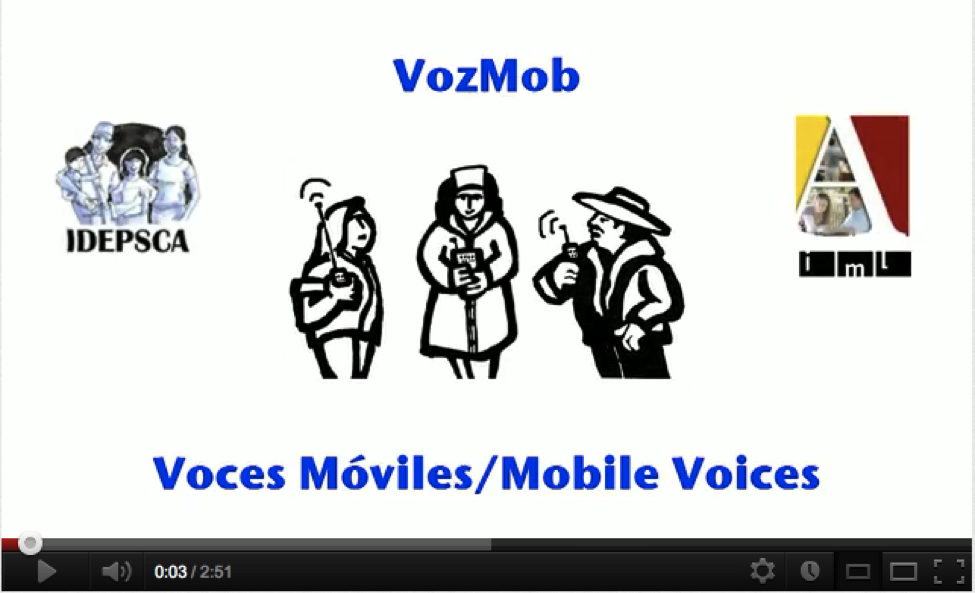
Figure 8. Screenshot of official VozMob video
one of the affiliated researcher-volunteers states, "On the research side, our partnership supports media justice efforts and seeks to advance the theory and practice of technology appropriation, participatory design, and action research."24 This commitment to research, however, appears to be secondary to the actual commitment to community participation. That official video, for example, features introductions and short monologues by the jornaleros, volunteers, and researchers. The same can be said for some of the VozMob presentations, for example at the HASTAC (Humanities, Arts, Sciences, and Technology Advanced Collaboratory) Conference 2010, where a variety of individuals participated in a video conference presentation that was not limited to just academics. This more democratic sharing of responsibilities and voices in different media and contexts has been integral to the recognition of this project, whose major celebrity is arguably Madelou, one of about thirty bloggers, a retired day laborer and active documenter for the site. Of particular note, regarding this promotional video for VozMob presented at the conference, is the multiplicity of voices and the lack of emphasis on any official "author." Several of the volunteers and bloggers (including Madelou) introduce themselves in the video, but their positions within their project are not demarcated, and there is no associated hierarchy that defines their roles with the project or that collaborative community.
Built on the Drupal open source content management system, VozMob makes all of its tools and code freely available through its website, furthering this notion of a collaboratively productive community. In addition, because of material boundaries that may emerge due to lack of access to cell phones—the primary tool of bloggers to capture media—VozMob actively makes itself a space open to contributions from any community member interested in documenting the lives of day laborers, by inviting potential bloggers to IDEPSCA's physical spaces throughout Los Angeles. This serves the purpose of fostering a community of activist bloggers online and off, and potentially lowering the boundary of entrance with the offerings of equipment use and volunteer guidance. Yet this could also be a factor that limits participation: because many of these day laborers are immigrants, migrants, or undocumented workers who often are already fearful of immigration officials, law enforcement, and nativist community members, this anxiety could act as an additional barrier. As a result, many of the bloggers remain relatively anonymous, identifying themselves only by their first names, while the most active blogger, Madelou, has become something of a celebrity because of her position of relative stability as a naturalized, English-speaking US citizen. Despite these very real concerns, there is still a palpable cohesiveness uniting all the contributions around issues of immigrant rights, labor rights, and related social justice issues. This cohesiveness is accomplished organically through the orientations of bloggers and volunteers, and through the active communities of participants who also have access to the off-line spaces of IDEPSCA offices to meet, socialize, and work.
Although these possible problems could limit participation in the project, the blog and site that ultimately materialize appear to be relatively well populated and primarily democratic, though with perhaps an even smaller body of regular participants than Flight Paths. All bloggers contributing information to the site are given their own profiles,
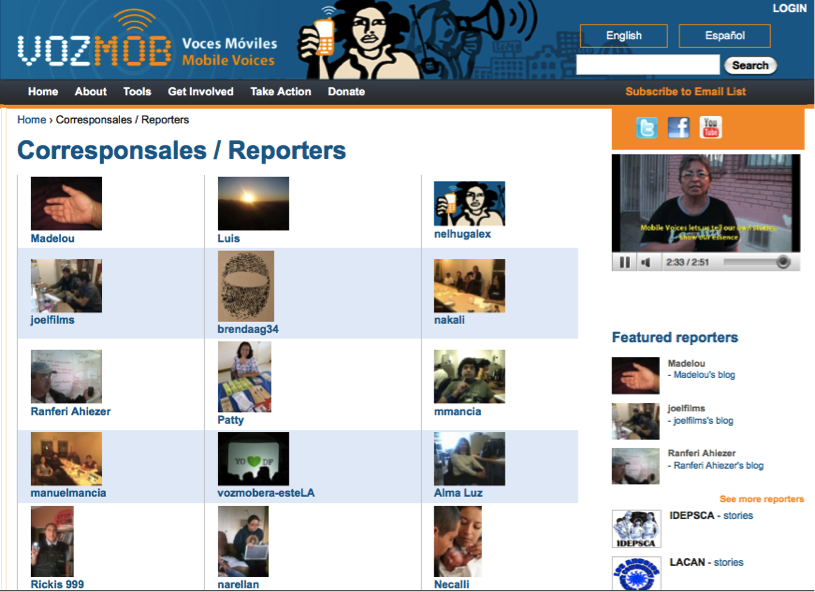
Figure 9. Screenshot of Corresponsales/Reporters page, which lists all contributors to the VozMob blog (captured April 8, 2012) http://vozmob.net/en/bloggers
linking to all of their blog entries. Once media is uploaded to the site, it is labeled "Stories," regardless of media type, and is listed under the New Stories section of the VozMob home page. Certain stories are also highlighted in the scrolling Featured Stories section of the main page, rotating among several other featured stories. Unlike Flight Paths Universe, at the VozMob site there is no discernable person (or people) doing the work of curating and posting the information to the larger site. According to the site's editorial policy, "every VozMob blogger has the ability to promote their own stories to featured stories. Site editors are also able to promote any story to be a feature. Bloggers and site editors use their judgment to choose featured stories, based on the mission, objectives, and general editorial policies of VozMob.net."25 Such a democratic, community-based system of ordering content suggests that there is no enforced hierarchy among the bloggers, and no types of media or information are more privileged than others. Instead, all uploads are available on the VozMob site, first arranged chronologically, and then searchable according to author or date.
In the end, VozMob endeavors to be not just a blog, but a site for the community. Unlike the Flight Paths network, VozMob is a central source of information, with many of the blog posts providing content for a print text, Jornada XXII, that is distributed in community centers such as IDEPSCA. This information is for the community and written by the community. Flight Paths, on the other hand, ideally combines multiple voices to tell the story of two people, Yacub and Harriet. Rather than retain the voices of the individual contributors, authors Pullinger and Joseph have primary control in the representations put forth by their now-stable digital text. In their blog, Pullinger and Joseph write, "There is no memorial to these men, and this piece will seek to address that," while noting that this is also an experiment "that could prove to be ground-breaking in its engagement with the networked environment and all the possibilities this environment offers to writers and readers."26 Much like the utopian rhetoric used by capitalist policymakers and the transnational classes who benefit from neoliberal economic policy, Pullinger and Joseph here evoke the idealistic language of early techno-utopianism, which declared the internet as the first and only true democratic space. For Pullinger and Joseph, the internet represents opportunity, and so long as they invest wisely (time, work, expertise), they will be rewarded with a profitable, recognizable accomplishment—in this case, a humane "monument." Pullinger and Joseph's end product, or as it stands in its five-chapter form at the start of 2012, is as much a heartfelt tribute to men like Yacub as it is a troubling salvific endeavor that recuperates the subaltern experience.
Although it makes a strong statement, the text presents a facile depiction of Yacub's experiences. Clearly, he must have suffered horribly as a worker to take the extreme risk of stowing away on an airplane. With this in mind, it is puzzling how little of Yacub as a character is actually offered to readers, and how spare is the depiction of his life in Dubai. For example, the first slide in Chapter 1, "Yacub in Dubai," states simply, "I went to Dubai from my home because I heard I could earn good money".
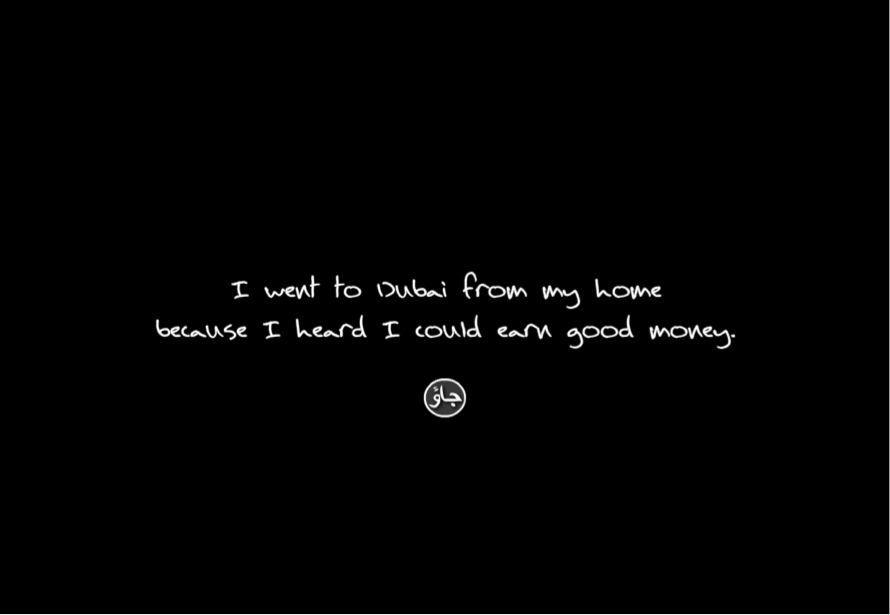
Figure 10.
Such a simple statement suggests that Yacub is just an opportunistic young man who, like Masao Miyoshi's "transnational class,"27 has no national or even familial ties, and is venturing to Dubai in search of only monetary gain. According to the narrative, Yacub is aware of the potential perils of a lifetime of labor in Dubai as described by a neighbor,
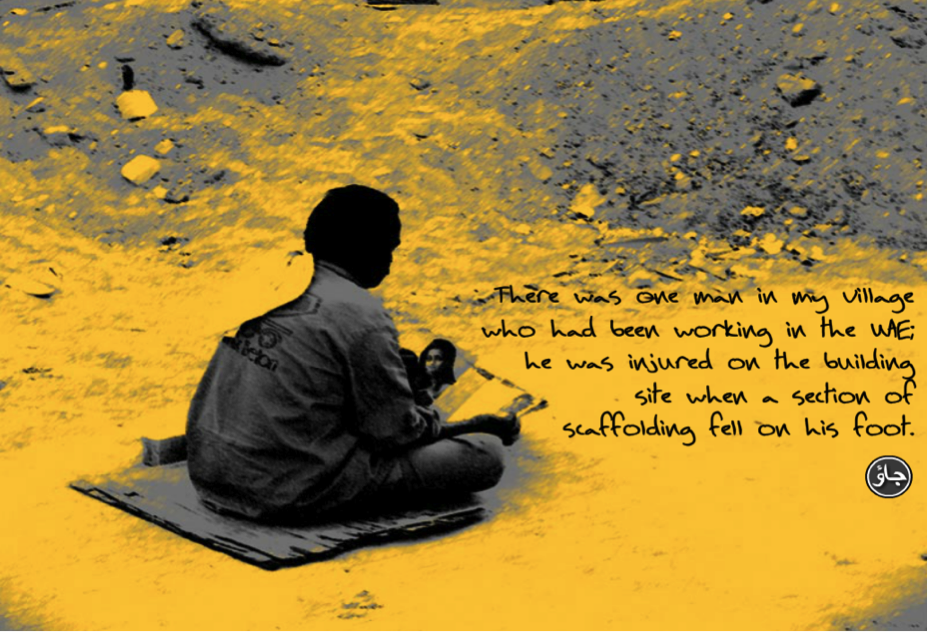
Figure 11.
presumably the seated man with an obscured face several slides later, who "had a lot of stories about what life was like in the worker's camps." Not long after, readers encounter a slide that depicts Yacub's feelings about Dubai, which continue to motivate him despite his neighbor's stories, unseen and unheard by the audience. He states in childish manner, "I liked the look of Dubai; I liked the idea of living somewhere where everything was new".
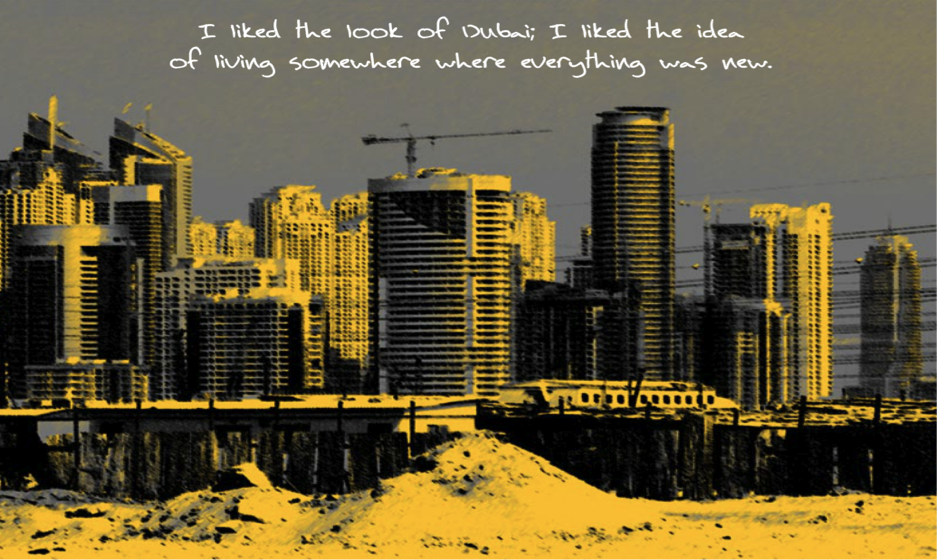
Figure 12.
Perhaps in spite of his friend's warnings, Yacub insists on harboring the dream that he will also be able to navigate the shiny new towers of Dubai. The accompanying rapid succession of images of Dubai under construction, covered in cranes and pits of dirt, behind a grey-and-yellow filter that gives them the quality of photographic negatives, along with echoing oud music, is in high contrast to Yacub's plain language. Dubai becomes alien and hostile, a stylized landscape distant from the simple perspective of the laborer. The feeling of hostility and foreignness, captured in images that obscure and make ambiguous the faces of the workers, is reflected in Yacub's brief statements. Of his trip, he states, "The plane to Dubai was full of men like me, of all ages, although I was one of the youngest." And of his actual work site, he writes, "The conditions were not good, worse than at home—too many men".
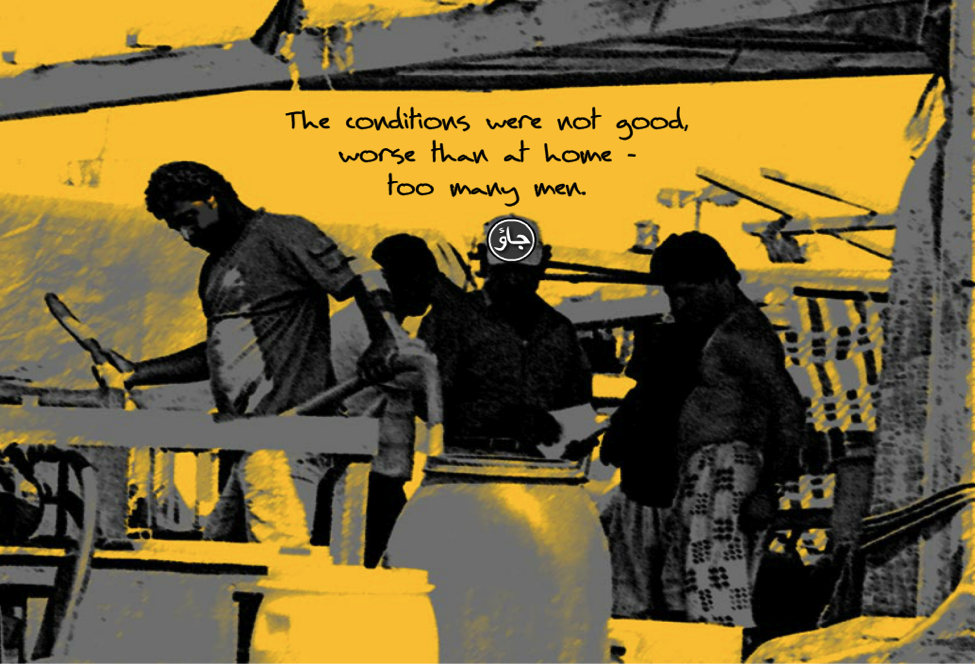
Figure 13.
Such a description suggests that the work site was overcrowded but does not speak to other poor conditions, such as low pay, long hours, extreme weather, intimidation, employment instability, and lack of safety precautions, which led Yacub's real-life counterparts to strike or flee to alternate work sites. Here, the text seems to suggest blame not only for the companies employing too many men, but also for the workers who attempt to work where they are not needed. The image itself, of a small cluster of dark men, the "too many men," centered in a bright yellow setting, implies that for Yacub, the men are the threats—not the larger, global structures that institutionalize disparities along hemispheric or national lines, and which keep men like Yacub in these precarious, risky positions by granting corporations the power to employ them without providing adequate protections necessary for humane working conditions.
When we next see Yacub, at least a full year has passed, and he is returning to Dubai after time off. In reality, his plan is to hide himself in the wheel bay of an airplane headed to London instead. In this series of slides in Chapter 2, "Yacub at the Airport," the alien but bright setting of Dubai is exchanged for the dark, monochromatic, metallic coldness of the technological hub of an airport.

Figure 14 a-c.
The melodic, unaccompanied strings of the first chapter are replaced by a soft, but increasingly thrilling, percussion accompanying the twang of the strings. The faces are more obscured, and the familiar sight of airplanes becomes even more intimidating and unfamiliar from the point of view of Yacub. In a parallel manner, we see Yacub changing form and becoming unfamiliar as his body is forced to accommodate the landing gears of the plane; he discovers that there is no way to get into the cargo hold, and realizes that he will die with his body wrapped around the landing gear. At this point, Yacub ceases to become Yacub and becomes a "Dark Mass," the title of the fourth chapter in the novel. Juxtaposed with London housewife Harriet's zombie-like walk through the fluorescent grocery store, Yacub's position is now glaringly horrific. His eventual freedom is in his release from the airplane, when he emerges as a dark mass, no longer recognizably human, against a beautifully dappled blue sky, and crashes into Harriet's car.
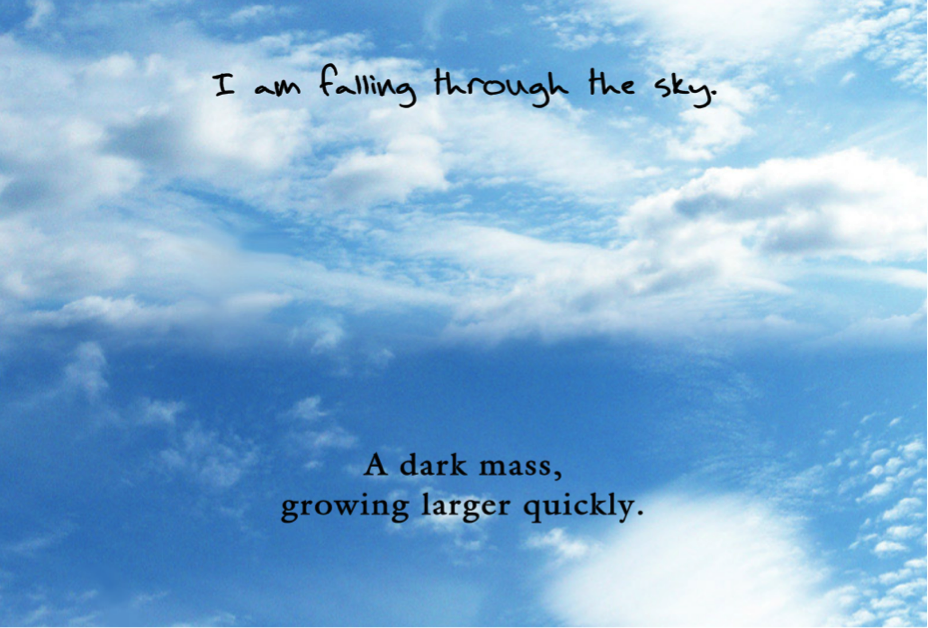
Figure 15.
Whether Yacub has actually survived this flight is unclear. It is unclear whether he is a zombie or a living man when he jumps up to retrieve Harriet's shopping basket and when he goes home with her. The ambiguity surrounding Yacub's status, both as a man and a mobile agent, is left unresolved.
What is striking is the emergence of Yacub as a disturbingly othered subaltern figure at the finale of the digital story, when he surfaces as an ambiguously undead body. Although the text does not make clear that Yacub has died and come back to life, the physical circumstances he would have found himself in ensure that survival would have been impossible. In the article that is cited as inspiration, Addley and McCarthy state in detail,
[T]he undercarriage compartment [where Yacub, and his real-life counterpart Ayaz, stowed away] has no oxygen, no heating and no pressure, and there is certainly no way out. By about 10 minutes into the ascent, the temperature in the wheelbay would have been freezing. At 18,000 ft, minutes later, while passengers only a few feet away were being served gin and tonic and settling down to watch in-flight movies, Ayaz would have begun to hallucinate from lack of oxygen. At 30,000 ft the temperature is minus 56 degrees. Even if the young man managed to escape being crushed by the retracting wheel mechanism, he was as good as dead from the moment his feet left the runway.28
Yacub's escape from Dubai aboard a plane, then, can only realistically end in tragedy, horror, and anonymity. Yet when Yacub jumps up, after crashing into Harriet's car, to retrieve her runaway shopping cart, the narrative unwittingly makes light of Yacub's ordeal and turns the scene into a sort of meet-cute between the two characters. The abrupt change in tone, from one of despair in the dark enclosed space of the wheel bay, to one of levity in the open space of a London parking lot, trivializes the horror of the story meant to memorialize refugees, and could even be counterproductive. In light of some comments on the blog, where Pullinger and Joseph publicly share their thoughts on the creative process, reading Yacub as a zombie image becomes even more troubling. In one entry, Pullinger writes, "Maybe zombies are about the human soul, or absence thereof, and maybe they are also about race."29 Zombies, figures already problematic because of their relations to the racialized and subaltern slave and laborer, become even more so when Pullinger makes this statement without actually engaging the issues she raises, other than to give us highly stylized multimedia snapshots with simplistic textual narration that elide the very real, very difficult material and social conditions of men like Mohamed Ayaz. The text thus refuses to recognize Yacub's death and his suffering, representative of a larger phenomenon brought on by inequity within the global economy; and only further marginalizes his story in favor of the aesthetics and potential of the digital medium.
If we turn to VozMob, we see that it manages to do some things more successfully than Flight Paths—for example, social justice and political education—but in terms of aesthetics and storytelling, it does not use the capacities offered by digital media to engage audiences as well as Flight Paths. As a site, VozMob is less about creative output, and more about providing an online space for a community organization, its members, and their activism. That said, the site is still not as easy to navigate, and there are no cohesive narratives that try to tie the various strands of the multiple perspectives together. The interface itself prevents such narratives from being read as such, even if that is the intent of their authors. The depth and complexity also varies from one post to the next, and from one blogger to the next. Sometimes, these posts can be a single decontextualized image or video, or they can be well-written arguments or summaries of important local events. For example, one recent post titled "La nueva imagen de R C L," by Gonzalez Luis,
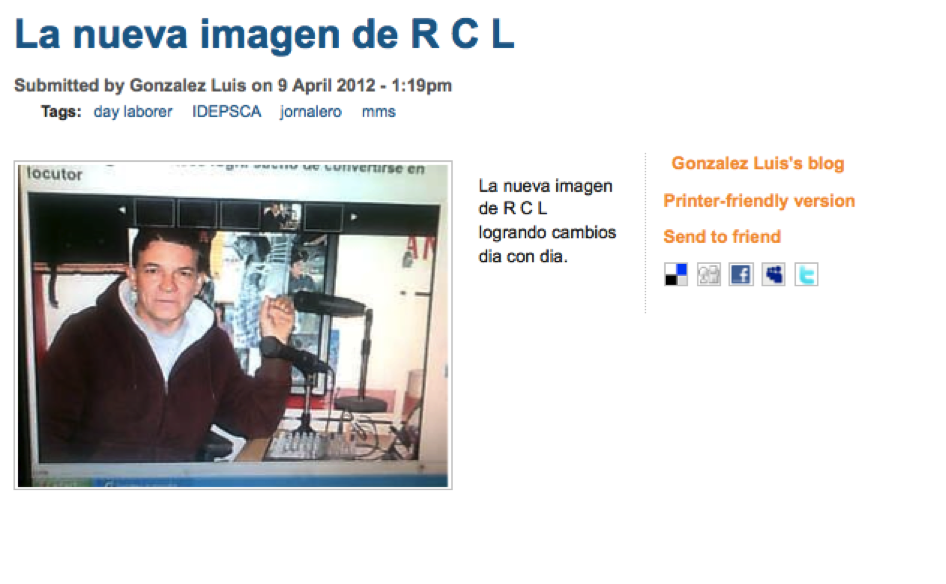
Figure 16.
posted on April 9, 2012, includes the reproduction of a print image of an unidentified man in front of radio recording equipment. Unless the reader spends time going through past posts by Gonzalez Luis, the history of this post is enigmatic, and it conveys little meaning. But a previous post titled "Radio Céntro Laboral sigue en," also by Gonzalez Luis,
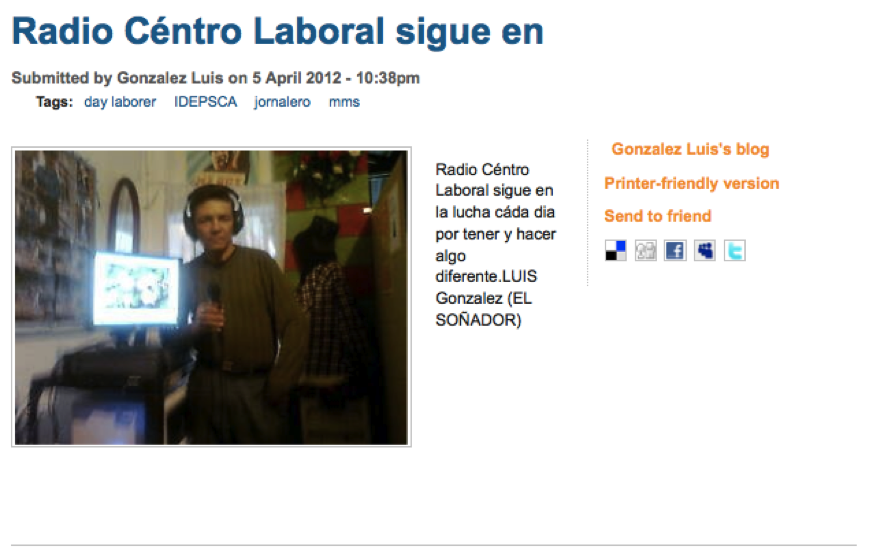
Figure 17.
makes clear that R C L refers to an online Spanish-language radio program, Radio Céntro Laboral, and Luis is the pictured disc jockey. Referring to himself as "El Soñador," or the Dreamer, Luis has used VozMob as a platform to document his experiences as a day-laborer-turned-radio-personality. Such a trajectory is hard to follow, as the layout of the site doesn't make following single narratives particularly easy.
Instead, the design of VozMob encourages a multiplicity of voices to appear almost simultaneously. The platform does allow the bloggers to "create stories about their lives," as the "About Vozmob" statement lays out, but these stories take considerable labor and investment by the reader to follow and engage. This asks more of readers, demanding that they spend time navigating the site, piecing together stories, and connecting them with the authors. Such a task can prove difficult, and the amount of noise that greets the casual visitor can act as a barrier to entry and may deter people from devoting the time needed to gain anything from the site. At the same time, many of the posts are stand-alone and do not require much investment from readers. One recent post featured on the main page and titled "Dangerous Work, Day Laborer Work!" simply offers an image of a man on a ladder, photographed from below. 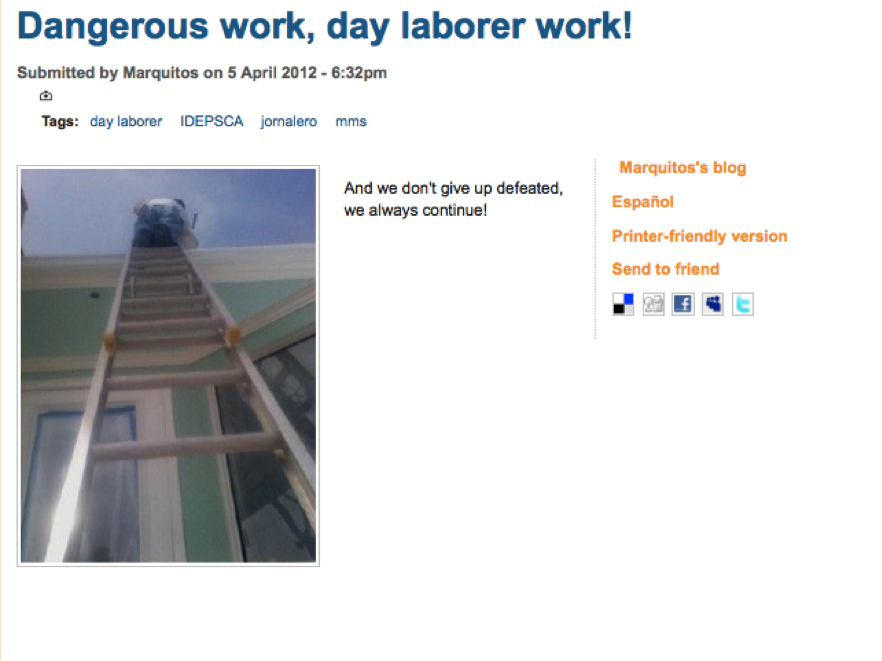
Figure 18.
Posted by Marquitos, the caption states, "And we don't give up defeated, we always continue!" Like most of the images on the site, the quality is grainy and not very clear. Such aesthetics evoke the working-class demographics of the contributor, and the unsteadiness of the perceived photographer suggests that the image was snapped in a stolen moment at work at a precarious job site. This photo, along with the exclamation, acts as a simple, clear testament to the sacrifice these workers must make every day. For them, working is dangerous, but it becomes part of their daily lives and identities; and capturing their work and sharing it becomes a brave act of giving testimony, often associated with the defiance of bearing witness. Rather than make a story to memorialize another, the bloggers for VozMob capture fragments of their own challenging lives to share and communicate in bits and pieces, so often invisible and unimportant to the average citizen. Unfortunately, not all of the posts to VozMob are so succinct and poignant in their communication strategies. In the end, the individual authors are given the freedom to tell their stories as they see fit.
Looking at these two texts and their approach to collaboration is very telling, and it has important implications for ongoing and future collaborative projects, especially in terms of labor, which here surfaces not just as a social and political issue, but also as a concern for the creative process. According to Pullinger and Joseph, the collaborative, digitally enabled writing process of Flight Paths had the potential to be "ground-breaking in its engagement with the networked environment and all the possibilities this environment offers to writers and readers," but was this the end result?30 Collaboration itself would have indeed been a fascinating way to combine multiple perspectives, considering the transnational and global nature of the narrative, which starts in Pakistan, sojourns in the Middle East, and ends in England. However, this discourse of collaboration enabled through technology smacks of digital utopianism, especially when the collaborative nature of the project becomes questionable; in this case, the text proves problematic because the editorial and curating process highlights the power inequalities that play out in the process of representation.
The social network that Flight Paths facilitates is arguably less about connecting and sharing, and more about collecting information so that a few (namely Pullinger and Joseph) can produce. On the other hand, VozMob presents us with a model that is more open, but also less readable. I must also note that it would be a little too simplistic to say that the potentialities and constraints of one textual form perpetuate economic and labor injustices, or that the other is more democratic and immediate. I won't hide the fact that I find VozMob the more productive of the two texts, though it is clearly not without its problems. Perhaps it is the capacity for self-representation, with all the shortcomings that this allows, that I find more liberating and transformative, rather than the already entitled position of authors and artists who have the ability to write the imagined story of a man, now dead.
Is there a way to write the story of Mohamed Ayaz so that his horrific experiences can function to commemorate him and others like him? I think that Amitava Kumar's attempt, in his short tortured essay "Flight," which imagines Ayaz's circumstances, the possibilities surrounding him, and then relates these back to the privileged status of the author, might be the only way to commemorate a life so little known and a voice that had no opportunity to narrate its own story. Kumar writes,
I can try to imagine the dreams that come to the stowaway when he begins to drift into sleep despite the cold and the noise in his shuddering cage. But these would be speculations. The stowaway will not share his secrets with the writer. It is impossible for me to know if the stowaway is nostalgic for the fields in his village and the familiar sunshine on the wall of his house. He had wanted to leave them behind. The plane is carrying him into the future. He tells himself that he can bear hunger for a long time [. . .] These are the thoughts that I surround the stowaway with, as if he were, in reality, trapped inside the darkness in my head. It is because I am telling myself over and over that he does not feel any pain. He feels light-headed. He is not fleeing anything anymore. He is flying.31
For Kumar, the author, writing from the perspective of another who is in a position so materially and socially different is impossible. All the author can do, in such a case, is speculate. For Kumar, he also hopes. It is not an optimistic hope that Ayaz will reach his destination, because the reality has already dictated otherwise. The hope is that Ayaz did not feel pain as he left this world.
For the writers of VozMob, a hope also underlies their work with the project: a hope for recognition that they are also people who deserve rights to citizenship and to safe working conditions, in a country that currently sees them as intruders and criminals and is willing to use them for their labor so long as it is cheap and they ask for nothing else. Because such a hope seems distant in the current political and economic climate, the writers take on the work of representation themselves, not willing to let others continue to misrepresent them, as has been done and to their detriment. Their work, then, is to produce a humanistic and heterogeneous polyphony of voices that brings complexity to a population that is continually dehumanized and made other.
Ultimately, I want to avoid arguing that collaborative digital storytelling about a disenfranchised and exploited population will result in problematic narratives. I believe the potential is there to create sensitive, well-informed, and socially transformative texts no matter the material form, but so much depends on the communities and individuals involved. When we take part in such endeavors, though, we must ask ourselves certain questions: How can migrant workers (or any community often mis- or underrepresented) be most productively represented or given voice? How should collaborators be included in the production processes and the textual forms? How do we evaluate their work? And finally, how do we read these processes, and the resulting texts, against the work they are trying to do? The fear, for me, is that favoring the author over the crowd may reduce them to a "dark mass," as Yacub was, when the goal has been to grant him new life, to make his experiences human and relatable, like those represented by Madelou, Gonzalez Luis, or Marquitos.
About the Author
Anne Cong-Huyen is a doctoral candidate in English at the University of California–Santa Barbara. Her dissertation, "Host and Server: The Cultural Production of Temporariness in Global Cities," draws from comparative literary and media studies, migration and labor studies, and network studies to examine the contemporary shift toward the temporary and transnational in the literature, film, and digital media of global cities. Her research focuses on the cities of Dubai, Los Angeles, and Ho Chi Minh City/Saigon. She is active as a founding member of the #transformDH Collective, which seeks to incorporate critical cultural studies into diverse digital humanities activities.
Endnotes
1 "Crowd Creativity," Crowdsourcing.org, 2010–2012, http://www.crowdsourcing.org/community/crowd-creativity/3.
2. Kate Pullinger and Chris Joseph, Flight Paths: A Networked Novel, Institute for the Future of the Book, 2009, http://www.flightpaths.net.
3. VozMob [Voces Móviles/Mobile Voices], Creative Commons Attribution-Noncommercial-Share Alike 3.0 License, 2008, http://vozmob.net/en.
4. See Mike Davis, "Sand, Fear, and Money in Dubai," in Evil Paradises: Dreamworlds of Neoliberalism (Berkeley: New Press, 2007), 48–68; Christopher M. Davidson, Dubai: The Vulnerability of Success (New York: Columbia University Press, 2009); and Jim Krane, City of Gold: Dubai and the Dream of Capitalism (New York: St. Martin's Press, 2009).
5. Los Angeles and Dubai have also been incredibly important destinations for intranational and regional migration, but this article focuses primarily on the role of foreign laborers. This is mainly because I am situating this work within larger debates about transnational labor and global networks. These networks will emerge, as the article continues, as important means of connectivity and mobility.
7 Krane, 254.
8 Ibid., 254.
9 At the time that this article was originally written, only five chapters had been published. A sixth chapter, "Jack Meets Yacub," was published in June 2012. For the purposes of this article, I will stick to the initial five chapters; in the sixth, Yacub (who has been living in Harriet's pantry) meets her son, Jack. Although there is an overt change of tone in this chapter, to that of a rock-music-scored, video-game style representing the perspective of the son, the text continues to problematically engage with Yacub's plight as he remains obscured from view ("I'm Yacub. I've been living in your pantry [. . .] Your mother thinks that I am dead and that no one can see me. Except her.") and his death is now associated with the simulated violence of video games ("He killed me?").
10 Pullinger and Joseph, Flight Paths (blog), http://www.flightpaths.net/blog/.
11 Awards that VozMob has earned include recognition of Best Mobile Content at the World Summit Awards (WSA) in 2010 in the category of m-Inclusion and Empowerment. WSA is an initiative of the United Nations Global Alliance for ICT and Development (UN-GAID), held in collaboration with UNESCO and UNIDO. See http://vozmob.net/en/story/mobile-voices-wins-world-summit-award.
12 Additional funding and sponsorship has also come from HASTAC, the MacArthur Foundation, the Social Science Research Council, and a growing list of affiliates.
13 "About Vozmob," VozMob, 2008, http://vozmob.net/en/about.
14 Pullinger and Joseph, Flight Paths (blog), "About," par. 6.
15 Esther Addley and Rory McCarthy, "The Man Who Fell to Earth," Guardian (July 17, 2001), accessed July 17, 2011, http://www.guardian.co.uk/uk/2001/jul/18/immigration.immigrationandpublicservices.
16 This quotation is from the official if:book blog, written by Ben Vershbow, Dec. 10, 2007, 12:59 a.m. It also appeared in the original blog by Pullinger, but was edited following the relaunch of the project site in 2009. See http://www.futureofthebook.org/blog/archives/2007/12/flight_paths_a_networked_novel.html.
17 Ben Mason and Sue Thomas, A Million Penguins Research Report, (Leicester, UK: Institute of Creative Technologies, De Montfort University, Apr. 24, 2008), 1, http://www.ioct.dmu.ac.uk/documents/amillionpenguinsreport.pdf.
18 Ibid., 1–16.
19 Ibid., 4–11.
20 Ibid., 4.
21 It is also important to note that Flight Paths is built on a proprietary Flash format, and even the Electronic Literature Collection could not host it on it own server, so the text is linked to its own site (http://www.flightpaths.net) from the collection.
22 Laura Borràs, Talan Memmot, Rita Raley, and Brian Stefans, eds., Electronic Literature Collection, vol. 2 (Cambridge, MA: Electronic Literature Organization, Feb. 2011), http://collection.eliterature.org/2/.
23 Cagonzal, "Notes from IDEPSCA Coordinators Meeting," July 29, 2008, http://vozmob.wordpress.com/2008/07/29/notes-from-idepsca-coordinators-meeting/.
24 VozMob, 1 min., 12 sec.
25 "Editorial Policy," VozMob, http://vozmob.net/en/editorial.
26Pullinger and Joseph, Flight Paths (blog), "About," par. 10, 11.
27Masao Miyoshi, "A Borderless World? From Colonialism to Transnationalism and the Decline of the Nation-State," Critical Inquiry 19, no. 4 (Summer 1993): 726–51, doi:10.1086/448695.
28Addley and McCarthy, par. 12.
29Pullinger and Joseph, "Zombies and Mad Scientists," par. 3, http://www.flightpaths.net/blog/index.php/zombies/.
30Pullinger and Joseph, "About," par. 11, http://www.flightpaths.net/blog/index.php/about-2/.
31Amitava Kumar, Bombay—London—New York (New York: Routledge, 2002), 234.
